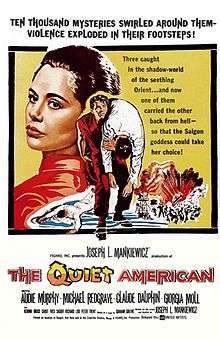The Quiet American (1958 film)
| The Quiet American | |
|---|---|
 Theatrical release poster | |
| Directed by | Joseph L. Mankiewicz |
| Produced by | Joseph L. Mankiewicz (uncredited) |
| Screenplay by | Joseph L. Mankiewicz |
| Based on |
The Quiet American 1955 novel by Graham Greene |
| Starring |
Audie Murphy Michael Redgrave |
| Music by | Mario Nascimbene |
| Cinematography | Robert Krasker |
| Edited by | William Hornbeck |
Production company |
Figaro |
| Distributed by | United Artists |
Release dates |
|
Running time | 120 minutes |
| Country | United States |
| Language | English |
The Quiet American is a 1958 American film and the first film adaptation of Graham Greene's bestselling novel of the same name,[1] and the first major American attempt to deal with the geo-politics of Indochina.[2] It was written and directed by Joseph L. Mankiewicz, and stars Audie Murphy, Michael Redgrave, and Giorgia Moll. It was critically well-received, but was not considered a box office success.
The film flips the novel on its head, turning a cautionary tale about foreign intervention into anticommunist advocacy of American power. In writing the script, Mankiewicz received uncredited input from CIA officer Edward Lansdale, who was often said to be the actual inspiration for the American character—called "Pyle" in the novel but unnamed in this film—played by Murphy.[1]
In a Hollywood still recovering from the effects of the blacklisting of suspected Communists, the film stirred up controversy. Greene was furious that his anti-war message was excised from the film, and he disavowed it as a "propaganda film for America."[1] The Quiet American was remade in 2002, directed by Phillip Noyce, with Brendan Fraser and Michael Caine, in a version more faithful to Greene's novel.[1]
Plot
In Saigon in 1952, as Vietnamese insurgents are delivering major strikes against the French colonial rulers, an innocent and enigmatic young American economist (Audie Murphy), who is working for an international aid organization, gets caught between the Communists and the colonialists as he tries to win the "hearts and minds" of the Vietnamese people. By promising marriage, he steals away a young Vietnamese woman (Giorgia Moll) from an embittered and cynical English newspaperman (Michael Redgrave), who retaliates by spreading the word that the American is actually covertly selling arms to the anti-Communists.
Cast
- Audie Murphy as The American (Alden Pyle)
- Michael Redgrave as Thomas Fowler
- Claude Dauphin as Inspector Vigot
- Giorgia Moll as Phuong
- Bruce Cabot as Bill Granger
- Fred Sadoff as Dominguez
- Kerima as Phuong's Sister (Miss Hel)[3]
- Richard Loo as Mr. Heng
- Peter Trent as Eliot Wilkins
- Georges Bréhat as French Colonel
- Clinton Anderson as Joe Morton
Production
The Quiet American started filming in Saigon on January 28, 1957, then moved to Rome, where shooting finished in late April 1957.,[4][5] It was the first time a feature film was shot in Vietnam.[6] The crew had some difficulty filming there — they had to avoid shooting at noon because of the harsh shadows, they had trouble receiving permission to shoot inside a Buddhist temple because of moon's phase, and they inadvertently helped a political protest take place that would otherwise have been shut down by the police, because the authorities assumed it had been staged for the film.[2] Audie Murphy fell ill with appendicitis during a weekend shopping trip to Hong Kong and had to be operated on.[7]
Humphrey Bogart was reported to have been considered to play the lead role, but it was first offered to Montgomery Clift, with Laurence Olivier to play "Fowler". When Clift withdrew for reasons of health, he was replaced by Audie Murphy and Olivier then left the project.[6][7]
Graham Greene had been a war correspondent in Indochina, and was critical of the growing American involvement there. By making the character of "Pyle" an aid worker and private citizen and not a representative of the U.S. government, and by focusing on the love triangle aspects of the story instead of the geo-politics of the war, producer-director-writer Joseph L. Mankiewicz significantly diluted the impact of Greene's story,[6] which led the author to disavow the film.
Phuong is a young Vietnamese woman, but actress Giorgia Moll is Italian.
Audie Murphy said he never would have done the movie if the tone of the story had not changed from anti-American to pro-American. He said "my part is one of the greatest I've ever had."[8]
Critical response
The film's obscuring of Greene's political points was mentioned by some critics, but the acting was nevertheless noted for its high quality, especially of Michael Redgrave. Also praised were the locations. Writing in The New York Times,[9] Bosley Crowther said: "Scenes shot in Saigon have a vivid documentary quality and, indeed, the whole film has an aroma of genuine friction in the seething Orient."[2]
References
- 1 2 3 4 Phillips, Richard. "A haunting portrait of US-backed terror in 1950s Vietnam" World Socialist Web Site, 2002
- 1 2 3 Steffen, James. "The Quiet American (1958)"
- ↑ Crowther, Gosley (Feb 6, 1958). "Movie Review: The Quiet American (1958)". Retrieved Feb 28, 2016.
- ↑ IMDB Filming locations
- ↑ TCM Overview
- 1 2 3 TCM Notes
- 1 2 Don Graham, No Name on the Bullet: The Biography of Audie Murphy, Penguin, 1989 p 268
- ↑ Hedda Hopper, 'Audie Murphy Will Do 'Quiet American' ', Los Angeles Times (1923-Current File) [Los Angeles, Calif] 14 Dec 1956: B8.
- ↑ "Quiet American: Mankiewicz Version of Novel by Greene" February 6, 1958
External links
- The Quiet American at the Internet Movie Database
- The Quiet American at the TCM Movie Database
- The Quiet American at AllMovie
- The Quiet American at the American Film Institute Catalog
- The Quiet American at Rotten Tomatoes
- The Quiet American at Audie Murphy Memorial Site